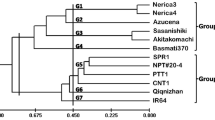Abstract
The genetic basis of heterosis was studied through mid-parent, standard variety and better parent for 11 quantitative traits in 17 parental lines and their 10 selected hybrids in rice (Oryza sativa L.). The characters were plant height. days to flag leaf initiation, days to first panicle initiation, days to 100% flowering, panicle length, flag leaf length. days to maturity, number of fertile spikelet/panicle, number of effective tillers/hill, grain yield/10-hill, and 1000-grain weight. In general the hybrids performed significantly better than the respective parents. Significant heterosis was observed for most of the studied characters. Among the 10 hybrids, four hybrids viz., 17A×45R, 25A×37R, 27A×39R, 31A×47R, and 35A×47R showed highest heterosis in 10-hill grain yield/10-hill. Inbreeding depression of F2 progeny was also studied for 11 characters of 10 hybrids. Both positive and negative inbreeding depression were found in many crosses for the studied characters, but none was found significant. Selection of good parents was found to be the most important for developing high yielding hybrid rice varieties.
Similar content being viewed by others
References
Allard, R. W., 1960. Principles of Plant Breeding. John Wiley and Sons, Inc., New York.
Alzona, A. V., Arraudeau, M. A., 1995. Heterosis in yield components of upland rice.Philippine J. Crop Sci.,17: 13.
Fanseco, S., Peterson, F. L., 1968. Hybrid vigor in a seven parent diallel cross in common wheat (T. aestivum L.).Crop Sci. 8: 85–88.
Johnson, T. E., Hutchinson, F. W., 1993. Absence of strong heterosis for life span and other life history traits inCaenorhabditis elegans.Genetics,134: 465–474.
Julfiquar, A. W., Tepora, N. M., 1994. Heterosis in some quantitative characters in F1 hybrid rice (Oryza sativa L.)Clsu Sci. J,12: 30–36.
Khaleque, M. A., Jorder, O. I., Eunus, A. M., 1977. Heterosis and combining ability in diallel cross of rice (Oryza sativa L).Bangla. J. Agril. Sci,4: 137–145.
Li, Z. K., Pinson, S. R. M. Paterson, A. H., Park, W. D., Stansel, J. W., 1997a. Epistasis for three grain yield components in rice (Oryza sativa L.).Genetics,145: 453–465.
Li, Z. K., Pinson, S. R. M., Paterson, A. H., Park, W. D., Stansel, J. W., 1997b. Genetics of hybrid sterility and hybrid breakdown in an inter-sub specific rice (Oryza sativa L.) population.Genetics,145: 1139–1148.
Mather, K., Jinks, J. L., 1982. Biometrical Genetics, Ed., 3. Chapman and Hall, London, New York.
Nuruzzaman, M., Alam, M. F., Ahmed, M. G., Shohael, M. A., Biswas, M. K., Amin, M. R., Hossain, M. M., 2002. Studies on parental variability and heterosis in rice (Oryza sativa L.).Pak. J. Biol. Sc.,5(10): 1006–1009.
Stebbins, G. L., 1958. The inviability weakness and sterility of interpecific hybrids.Adv. Genet,9: 147–215.
Stuber, C. W., 1994. Heterosis in plant breeding.Plant Breed. Rev.,12: 227–251.
Virmani, S. S., 1994. Heterosis and Hybrid Rice Breeding. Springer-Verlag, Berlin Heidelberg, Germany.
Virmani, S. S., 1998. Hybrid Rice Research and Development in the Tropics.In: Virmani, S. S., Siddiqe, E. A., Muralidharan K; editors. Advances in Hybrids Rice Technology. Proceeding of the 3rd International Symposium on Hybrid Rice, 1996, Hydarabad, Manila, Philippines, International Rice Research Institute, India, p. 35–49.
Virmani, S. S., Young, J. B., Moon, H. P., Kumar, I., Finn, J. C., 1991. Increasing Rice Yields through Exploitation of Heterosis. IRRI. Los Baños, Laguna, Philippines, p. 12.
Virmani, S. S., Viraktamath, B. C., Casal, C. L., Toledo, R. S., Lopez, M. T., Manalo, J. O., 1997. Hybrid Rice Breeding Manual. International Rice Research Institute, Los Banos, Laguna, Philippines, p. 7.
Wright, S., 1977. Evaluation and the Genetics of Populations. University of Chicago Press, Chicago.
Yu, S. B., Li, J. X., Xu, C. G., Tan, Y. F., Gao, Y. J., Li, X. H., Qifa, Z., Saghi, M. A., 1997. Importance of epistasis as the genetic basis of heterosis in an elite rice hybrid.Proc. Natl. Acad. Sci.,94: 926–931.
Zhang, Q., Gao, Y. J., Yang, S. H., Ragab, R. A., Maroof, M. A. S., Li, Z. B., 1994. A diallel analysis of heterosis in elite hybrid rice based on RFLPs and microsatellites.Theor. Appl. Genetics,89: 185–192.
Author information
Authors and Affiliations
Corresponding author
Additional information
Project supported by the Foundation of Ministry of Science and Information and Communication Technology, People's Republic of Bangladesh
Rights and permissions
About this article
Cite this article
Alam, M.F., Khan, M.R., Nuruzzaman, M. et al. Genetic basis of heterosis and inbreeding depression in rice (Oryza sativa L.). J. Zheijang Univ.-Sci. 5, 406–411 (2004). https://doi.org/10.1631/jzus.2004.0406
Received:
Accepted:
Published:
Issue Date:
DOI: https://doi.org/10.1631/jzus.2004.0406




